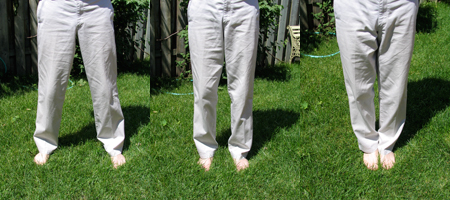Body Alignment
Alignment is something that has been part of Actor training for a very, very long time. In old days, it was called Posture, or sometimes Deportment, and it was about how to hold your body so that it looked the way you wanted it to. Today, we use the term Alignment, which has come to the Actor Trainers' vocabulary by way of the Alexander Technique. First created by an Australian, F.M. Alexander (1869-1955) in the 1890s, Alexander Technique (or A.T. as its proponents call it) is a hands-on means of exploring and balancing the tensions in the body necessary to do anything. I am by no means a trained Alexander teacher, but I highly recommend that actors-in-training seek out an Alexander teacher, so that you can begin to explore how your own use of your body helps and hinders your work. Teachers can be found throught the Alexander Technique website, at www.alexandertechnique.com
Here I hope to guide you toward some simple suggestions about how to approach standing, sitting and lying down when working on voice. These are merely guidelines, and not hard and fast rules. If it doesn't feel comfortable, you may want to shift out of the position for a while. However, our habits often tell us that something new is "not natural", when really, it's merely new, and therefore we are not yet habituated to it. Learning to feel comfortable in any new mode of doing takes time, practice and patience. If you always give in to the voice in your head that says "that's uncomfortable" and resort to slouching, you'll struggle to change your pattern. For more on how to change your pattern, you might investigate The Performance School , an online self-study guide to the Alexander Technique. They have a very helpful experiment page that specifically addresses Slumping.
STANDING
Stand with your feet in parallel. For some people, this feels as if they are "toeing in," because they are used to standing with their feet turned out. Stand with your feet, knees and hips aligned, stacking your leg joints vertically as best you can. Because you may have knock-knees or bow legs, you can only do this as best you can, but that should be your guideline. Your knees should be somewhat bouncy, not locked or hyper-extended. It helps to think of length in your legs, rather than feeling compression in your joints. Be sure to avoid standing with your feet together, or with your feet to wide apart.

Your lower back should neither be flat nor too deeply curved. You want to feel as if your shoulders are wide in both the front and the back. Often people pinch their shoulder blades together in order to compensate for collapsed shoulders. You want to feel both wide and opening in the front AND in the back. Your head should be balanced on your neck, not thrusting forward, pulled too far back, and your gaze should be ahead, not down toward the floor or up at the ceiling. Let your head float up toward the ceiling, so the neck feels long and easy, rather than collapsed. Again, finding the right balance of all your body parts takes a lot of experimentation and exploration, and the best way to find that is with a teacher, rather than on your own.
SITTING
Sitting in a chair is very similar to standing, in terms of alignment. You want to allow your torso to be balanced on your "sitting bones" (iscial tuberosity), so you can stack your spine up, letting your head float up. Let your hands rest on your thighs, with your shoulders wide across the front and back. For people with shorter legs, be sure to sit forward in your chair far enough so that you can sit with your feet comfortably on the floor. You might also put a phone book under your feet, so that you don't have your feet dangling over the edge of the chair.
Your feet, knees, hips should be aligned, so that each joint is roughly hip width apart. Don't cross your legs. For those who have studied musical instruments, you may be familiar with this form of sitting from band or orchestra practice.
LYING DOWN
Lying down is pretty easy, or so we all think. But lying down mindfully takes some care. Again, you want to align your legs so that you are roughly lying as you would be when you're standing, with feet, knees and hips in alignment. Your feet can fall open here, into a more "turned out" manner, if that's comfortable, though I would avoid allowing your toes to turn in. Your arms should be down by your sides, with your hands at roughly hip level. You can let your palms turn up to the ceiling, if that is comfortable, but it's not required.
The place that probably deserves extra attention in lying down is how to put your head. Most of us are used to lying on a bed, often lying on our sides or on our fronts, rather than squarely on our backs. To align your head, you want to be sure that you can keep your head in an alignment similar to what you might have when you're standing, floating your head up to the ceiling. For some, this requires a small book be placed under the head in order for the head and neck to be in a comfortable position.